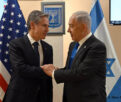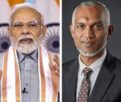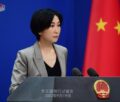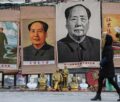Media Attacks: US and India

by Atul Cowshish
Donald Trump had no difficulty in getting the ‘hard pass’ (accreditation) of a CNN journalist suspended immediately after Jim Acosta had persisted with his ‘aggressive’ questioning of the US President at a Press conference at the White House. It was an unprecedented incident. US Presidents are used to facing ‘aggressive questioning’ by reporters but never before an accredited journalist had to face virtual ban on attending a White House Presser.
The show of a direct attack on Press freedom at the US Presidential Palace did little to salvage the image of Trump as a media baiter. But to be fair to him he appears to be quite happy with this image. He sees himself as a crusader against the ‘fake news’ phenomenon that he thinks dominates the US media scene. He is upfront in declaring the US media—the larger section of it—as his ‘enemy’.
It is very different in India where generally speaking the larger section of the media is happy to suspend its traditional watchdog role to present Narendra Modi a leader who cannot be replaced. His faults are glossed over. Most interestingly, there is willing acceptance of Modi’s dislike for being questioned—neither ‘aggressively’ nor even mildly. That much has been clear from the fact that Modi has refused to meet the Press after taking over as Prime Minister in May 2014.
While Trump has to constantly return media fire with his own brand of aggression, Modi remains in the winning position without having to enter the boxing arena to achieve his goal of keeping the media hounds away. Trump could well be envying Modi’s privilege.
But Modi should not really be happy with the Indian media’s one-sided love affair with him. The advantage that he enjoys from the voluntary submission by the media will one day—may be sooner rather than later– boomerang on him. An obedient media may suppress the problems faced by people brought about by his whimsical handing of affairs of the nation but the anger of the affected people will eventually boil over; it may spill over to the streets.
For the moment it appears that the duo of Narendra Modi and the BJP president, Amit Shah, has a free run and at best can expect no more than a limited scrutiny of the drawbacks in their style of governing the country. It appears like a cry in the wilderness when matters like farmers’ distress or joblessness are raised in some quarters. Demonetisation may have been dubbed a disaster by economists but the louder voice—government propaganda–in its support drowns the contrary view.
How easy it has been for the government to divert attention from the assurances given by Modi on the day he announced ban on circulation of Rs 500 and Rs 1000 notes two years ago. He had talked about demonetisation as a means to end black money, corruption, terror financing and fake currency circulation. A byproduct of all this was supposed to be a body blow to terrorism.
Modi had stated that he would not allow the pain of demonetisation to last long. In fact, he had said in his televised address to the nation while announcing ban on high denomination currency notes that he would be ready to accept any punishment—he offered even his head—if the travails of the common people did not end in ‘fifty days’.
Of course, all that proved to be yet another of example of using ‘jumlas’ (false promises) to drum up support for Modi. The goalposts have been effectively shifted by the media on a cue from the government. It is being said that among the benefits demonitisation brought was a rise in tax revenues; country moving swiftly into cashless society was another.
At best such claims are only partially true. It is amazing that demonetisation was the only way to collect more taxes, just as it is a puzzle how would the Modi government thought of welfare schemes had petrol prices not gone down drastically. The media has not asked what punishment should be given to Modi for not fulfilling the promises he had made on that unfortunate evening in November 2016. The media does not ask Modi to at least express some regret over the 100-plus deaths caused as a result of the endless wait by people outside banks for exchanging old notes for new ones.
That Modi almost invariably makes an ‘election speech’ is understandable, given his burning desire to stay in power for the rest of his life in a virtual one-party state. But he is allowed to get away by making statements not backed by facts, even if the facts are given by his own government! Contrition is not known to Modi, no matter how serious a matter may be, concerning deaths of innocent, defiance of court orders and open resort to hate politics.
Trump may not be very different from Modi in all this but the larger part of the US media that he hates so much does not bestow the kind of adulation that can be noticed among the influential newspapers in India. The leading US newspapers and TV channels have not capitulated to him the way their Indian counterparts have.
The Indian TV channels, barring a few exceptions, do not sound very different from their counterparts in countries like China and North Korea. Those two countries do not have to flaunt democratic credentials but the media in India is supposed to work under a democratic set up.
Modi scores over Trump in media relations because the fourth estate in India has no teeth, having got them extracted at the very beginning of the Modi regime. Trump tries to break the jaws, so to say, of the vast number of ‘unfriendly’ media in his country with perhaps only a limited success.
The recent mid-term polls in the US would seem to suggest that Trump’s ratings have dropped drastically though it must be admitted that the kind of nationalist fervour he generates among White Americans has not diminished much. The racial bigots in the US are the core of Trump’s supporters. But it is open to question if they are in a position to help Trump get another four-year term.
Modi’s followers are not very different from Trump’s in that they can also be called right-wing extremists who are known for their jingoistic nationalism. But in India also it remains to be seen if these followers can help Modi fulfill his ambition of being a life-long ruler.
-
Book Shelf
-
 Book Review
DESTINY OF A DYSFUNCTIONAL NUCLEAR STATE
Book Review
DESTINY OF A DYSFUNCTIONAL NUCLEAR STATE
- Book ReviewChina FO Presser Where is the fountainhead of jihad?
- Book ReviewNews Pak Syndrome bedevils Indo-Bangla ties
- Book Review Understanding Vedic Equality….: Book Review
- Book Review Buddhism Made Easy: Book Review
- Book ReviewNews Elegant Summary Of Krishnamurti’s teachings
- Book Review Review: Perspectives: The Timeless Way of Wisdom
- Book ReviewNews Rituals too a world of Rhythm
- Book Review Marx After Marxism
- Book Review John Updike’s Terrorist – a review
-
-
Recent Top Post
-
 NewsTop Story
What Would “Total Victory” Mean in Gaza?
NewsTop Story
What Would “Total Victory” Mean in Gaza?
-
 CommentariesTop Story
The Occupation of Territory in War
CommentariesTop Story
The Occupation of Territory in War
-
 CommentariesTop Story
Pakistan: Infighting in ruling elite intensifies following shock election result
CommentariesTop Story
Pakistan: Infighting in ruling elite intensifies following shock election result
-
 CommentariesTop Story
Proforma Polls in Pakistan Today
CommentariesTop Story
Proforma Polls in Pakistan Today
-
 CommentariesTop Story
Global South Dithering Away from BRI
CommentariesTop Story
Global South Dithering Away from BRI
-
 News
Meherabad beckons….
News
Meherabad beckons….
-
 CommentariesTop Story
Hong Kong court liquidates failed Chinese property giant
CommentariesTop Story
Hong Kong court liquidates failed Chinese property giant
-
 CommentariesTop Story
China’s stock market fall sounds alarm bells
CommentariesTop Story
China’s stock market fall sounds alarm bells
-
 Commentaries
Middle East: Opportunity for the US
Commentaries
Middle East: Opportunity for the US
-
 Commentaries
India – Maldives Relations Nosedive
Commentaries
India – Maldives Relations Nosedive
-
AdSense code



















